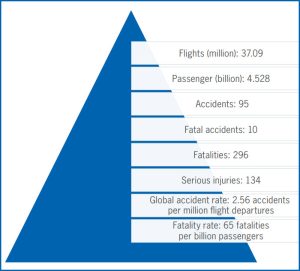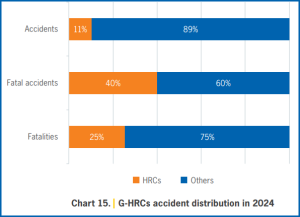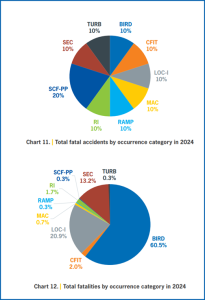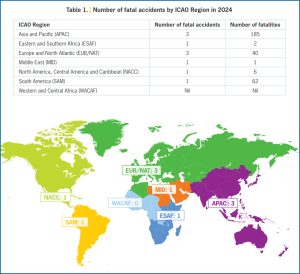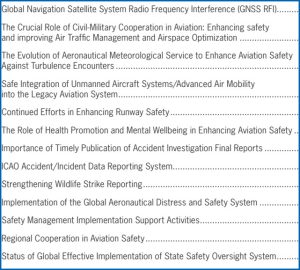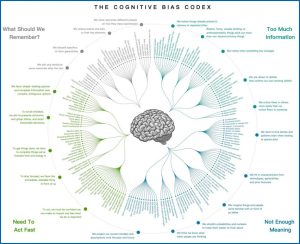ICAO’s Safety Report’s numbers –A WAKE-UP CALL???
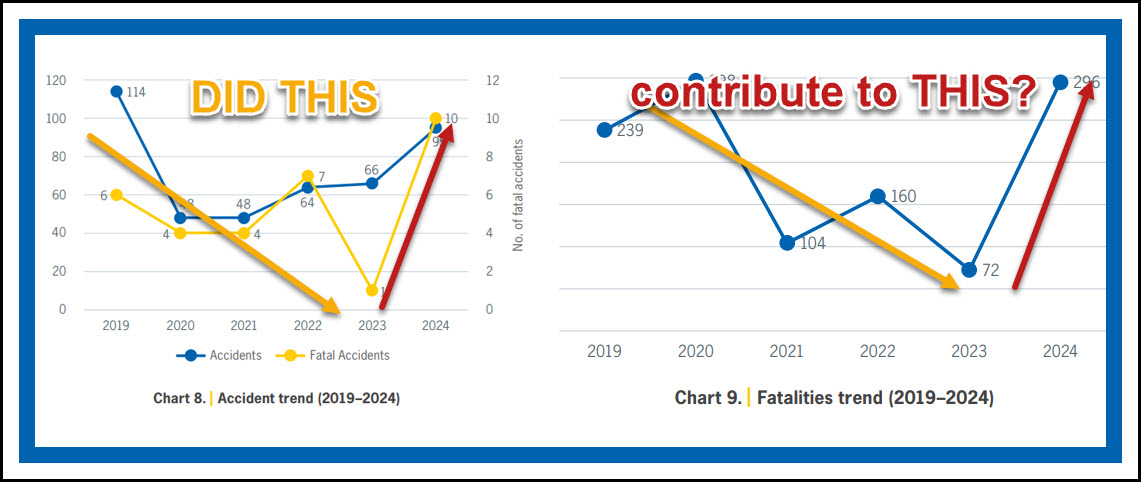
The International Civil Aviation Organization’s most important mission is to promote AVIATION SAFETY among all its Member States. Annually ICAO publishes its STATE OF GLOBAL AVIATION SAFETY. In this period of meta data, the UN’s designated aviation safety agency has compiled 84 pages that assess the numbers collected, identify trends and offer possible preventative actions.
The ICAO Secretary General Juan Carlos Salazar articulated the primary lesson of the report by stating:
“While global aviation safety trends continue to be positive, statistics published today by the International Civil Aviation Organization (ICAO) provide a STARK REMINDER OF THE NEED TO HEIGHTEN AND BROADEN GLOBAL COOPERATION on key safety priorities, particularly as flight volumes increase worldwide.”
The excellent tables, charts and discussion commend all aviation safety professionals to take the time to read all of he pages. The information provided is based on global experience and while the specifics cited are not directly relevant to your aviation operations, the accidents/incidents/trends mentioned provide food for thought, i.e. “NO, my MRO does not deal with avionics, but scrutinizing what is happening (lack of attention to detail?) should heighten your awareness of that risk in the context of your team.
Here are some of the highlights of the ICAO work
-
-
-
-
-
-
-
-
-
-
-
-
-
-
-
-
- Based on actual fatalities, high fatality risk per accident or the number of accidents and incidents, as well as results from the analysis of safety data collected from proactive and reactive sources of information from ICAO and other non-governmental organizations, ICAO has identified five G-HRCs as global safety priorities in the 2023-2025 edition of the GASP:
- controlled flight into terrain (CFIT);
- loss of control in-flight (LOC-I);
- mid-air collision (MAC);
- runway excursion (RE); and
- runway incursion (RI).
- Based on actual fatalities, high fatality risk per accident or the number of accidents and incidents, as well as results from the analysis of safety data collected from proactive and reactive sources of information from ICAO and other non-governmental organizations, ICAO has identified five G-HRCs as global safety priorities in the 2023-2025 edition of the GASP:
-
-
-
-
-
-
-
-
-
-
-
-
-
-
-
Global High Risks as % of totals
Fatalities and accidents by occurrence category
From a non-quantitative perspective and without the ability to delve further into the ICAO numbers, it may be that the difference in the ’23 v. ’24 performance may be attributable to OVERCONFIDENCE. Having reduced accidents year-over-year, might it not be possible that the industry focus has become complacent. That to do what you have done in the recent past has diminishes your attention to out risks. Last year’s habits contributed to good operations in the past, but your present vision may not see new problems– for example, greater challenges from weather –CONFIRMATION BIAS?. Or, you still hold your SMS team evaluation meetings, but the level of attacking of the problems is not as vigorously- OPTIMISM BIAS??? Relying on past techniques or processes may result in unconscious internal thought processes that degrade current judgments. Conformation, Optimism, Recency, Primacy, Halo/Horn, Centrality and the Law of Small Numbers are all possible sources for lessened safety focus. It is a phenomena that has been highlighted before as its impact on aviation safety.
Safety Culture depends on the minimization or elimination of such thinking. These subtle, almost hidden attributes may impact on thinking are not susceptible to self-evaluation. To determine whether your SMS Risk Assessments may be influenced by these biases, it would be advisable to incorporate an independent review by professionals with experience like the SafeAssure™ Safety Risk Assessment Program
Latest ICAO aviation safety data reveals need for renewed focus, despite continuous long-term improvements
Montréal, 11 August 2025 — While global aviation safety trends continue to be POSITIVE, statistics published today by the International Civil Aviation Organization (ICAO) provide a stark reminder of the NEED TO HEIGHTEN AND BROADEN GLOBAL COOPERATION ON KEY SAFETY PRIORITIES, particularly as flight volumes increase worldwide.
84 PAGES
The data in ICAO’s 2025 Edition Safety Report – State of Global Aviation Safety shows 95 ACCIDENTS involving scheduled commercial flights LAST YEAR, compared to 66 ACCIDENTS in 2023. Ten of those accidents were fatal, with the total number of fatalities reaching 296, up from 72 the previous year. The global accident rate also rose, to 2.56 accidents per million departures, compared to 1.87 in 2023.
These accident figures remain lower than pre-pandemic levels and come as the aviation system accommodated record breaking traffic volumes, with over 37 million departures worldwide.
“Aviation remains the safest form of transport, and the long-term trend demonstrates continuous improvement,” remarked ICAO Secretary General Juan Carlos Salazar.
“The figures from 2024 are a tragic and timely reminder that sustained, collective action is necessary to keep advancing toward ICAO’s goal of zero fatalities in commercial air transport,” remarked ICAO Council President Salvatore Sciacchitano. “ICAO will reinforce its advocacy and support for robust safety management, innovation, and international collaboration towards this goal.”
ICAO’s analysis identified FOUR HIGH-RISK CATEGORIES that accounted for 25 percent of fatalities and 40 percent of fatal accidents in 2024:
- CONTROLLED FLIGHT INTO TERRAIN,
- LOSS OF CONTROL IN FLIGHT,
- MID-AIR COLLISION and
- RUNWAY INCURSION.
The organization also noted that turbulence accounted for nearly three-quarters of all serious injuries[1], pointing to the increasing impact of weather-related hazards.
To address these specific risks and other emerging risks, ICAO is advancing several targeted initiatives. Global runway safety action plans aim to reduce runway excursions and incursions, while enhanced real-time turbulence monitoring systems will help aircraft operators better anticipate and avoid severe weather.
Today’s report also addresses the growing threat of Global Navigation Satellite System (GNSS) radio frequency interference, which ICAO is mitigating through the development of enhanced guidance on spoofing and jamming mitigation, updating navigation manuals to better handle GNSS disruptions, and working with international partners to establish protective frameworks to safeguard these systems.
Enhanced systems for accident/incident and wildlife strike reporting are supporting a MORE DATA-DRIVEN APPROACH TO INDUSTRY SAFETY, which will help identify emerging risks before they lead to accidents. In this regard, ICAO reported progress in transparency and learning from past events.
Finally, ICAO has highlighted the importance of promoting enhanced civil-military cooperation to address conflict related risks.
Looking further forward, ICAO is preparing for tomorrow’s technologies by developing safety frameworks for the safe integration of unmanned aircraft and advanced air mobility vehicles into traditional airspace, which is another significant focus of today’s publication.
ICAO’s report also reveals trends specific to regions.
The ASIA-PACIFIC AND EUROPE/NORTH ATLANTIC regions each recorded THREE FATAL ACCIDENTS during the reporting period, while one event in South America resulted in 62 fatalities. The Asia-Pacific region saw the highest overall fatality count, followed by South America and Europe/North Atlantic.
The report provides more details into the factors determining these outcomes in each region, including the support and coordination being implemented by ICAO Regional Offices and implementation support mechanisms to maintain and continuously improve aviation safety at the regional level.
[1] Brilliant AI-based turbulence avoidance system- AVOID FAA approval DELAY???
